Research on the Frequency-Dependent Halfwave Voltage of a Multifunction Integrated Optical Chip in an Interferometric Fiber Optic Gyroscope
Abstract
:1. Introduction
2. Theory and Simulation
2.1. Origin
2.2. Effect on Interference Light Intensity
3. Experiment
3.1. Measurement Method
3.2. Experiment Result
4. Discussion
5. Conclusions
Author Contributions
Funding
Conflicts of Interest
References
- Lefèvre, H.C. The Fiber-Optic Gyroscope, 2nd ed.; Artech House: Boston, MA, USA, 2014. [Google Scholar]
- Lefèvre, H.C. Potpourri of comments about the fiber optic gyro for its 40th anniversary, and how fascinating it was and it still is! Proc. SPIE 2016, 9852, 985203. [Google Scholar]
- Christova, K.; Kuneva, M.; Tonchev, S. Stress in LiNbO3 proton-exchanged waveguide layers. J. Phys. Conf. Ser. 2010, 253, 012057. [Google Scholar] [CrossRef]
- Yang, J.; Yuan, Y.; Zhou, A.; Cai, J.; Li, C.; Yan, D.; Huang, S.; Peng, F.; Wu, B.; Zhang, Y.; et al. Full evaluation of polarization characteristics of multifunctional integrated optic chip with high accuracy. J. Lightw. Technol. 2014, 32, 4243–4252. [Google Scholar] [CrossRef]
- Sathian, J.; Jaatinen, E. Reducing residual amplitude modulation in electro-optic phase modulators by erasing photorefractive scatter. Opt. Express 2013, 21, 12309–12317. [Google Scholar] [CrossRef] [PubMed]
- Bi, R.; She, X.; Shu, X.; Liu, C. Influence of the modulation phase error on bias error in interferometric fiber optic gyroscope. Opt. Eng. 2018, 57, 087104. [Google Scholar]
- Yao, J.; Li, K.; Li, B.; Wang, C.; Chen, K.; She, X.; Shu, X. Study of wavelength temperature stability of multifunctional integrated optical chips applied on fiber optic gyroscopes. J. Lightw. Technol. 2018, 36, 5528–5535. [Google Scholar] [CrossRef]
- Ding, R.; Jones, T.B.; Kim, W.J.; Spott, A.; Fournier, M.; Fedeli, J.; Huang, S.; Luo, J.; Jen, A.K.Y.; Dalton, L.; et al. Sub-volt silicon-organic electro-optic modulator with 500 MHz bandwidth. J. Lightw. Technol. 2011, 29, 1112–1117. [Google Scholar] [CrossRef]
- Ding, R.; Baehr-Jones, T.; Liu, Y.; Bojko, R.; Witzens, J.; Huang, S.; Luo, J.; Benight, S.; Sullivan, P.; Fournier, M.; et al. Demonstration of a low VπL modulator with GHz bandwidth based on electro-optic polymer-clad silicon slot waveguides. Opt. Express 2010, 18, 15618–15623. [Google Scholar] [CrossRef] [PubMed]
- Mao, X.; Tian, Q.; Zhang, E.; Sun, L.; Teng, Y.; Liu, J. Research on multiple-integrated optic-chip of re-entrant fiber optic gyro. Int. Opt. Sens. Spectrosc. 2005, 5826, 635–644. [Google Scholar]
- Liu, Y.; Li, Y.; Ji, Z.; Xu, J. Research on the half-wave voltage stability of Y waveguide in FOG. Chin. J. Sci. Instrum. 2010, 31, 449–453. [Google Scholar]
- Yang, F.; Yang, Y.; Han, Z.; Cao, Y. Correlation of wavelength and temperature with the half-wave voltage for Y branch optical modulator. Chin. J. Lasers 2016, 43, 0606002. [Google Scholar] [CrossRef]
- Takeda, K.; Hoshina, T.; Takeda, H.; Tsurumi, T. Electro-optic effect of lithium niobate in piezoelectric resonance. J. Appl. Phys. 2012, 112, 124105. [Google Scholar] [CrossRef]
- Nikitenko, A.N.; Volkovskiy, S.A.; Mikheev, M.V.; Aleynik, A.S.; Kikilich, N.E. Influence of acousto-optic resonances in electro-optical modulator on fiber optic gyro performance and method for its compensation. IEEE Sens. J. 2018, 18, 273–280. [Google Scholar] [CrossRef]
- Alferness, R.C. Waveguide electrooptic modulators. IEEE Tans. Microw. Theory Tech. 1982, 30, 1121–1137. [Google Scholar] [CrossRef]
- Tran, M.A.; Komljenovic, T.; Hulme, J.C.; Kennedy, M.J.; Blumenthal, D.J.; Bowers, J.E. Integrated optical diver for interferometric optical gyroscopes. Opt. Express 2017, 25, 3826–3840. [Google Scholar] [CrossRef] [PubMed]
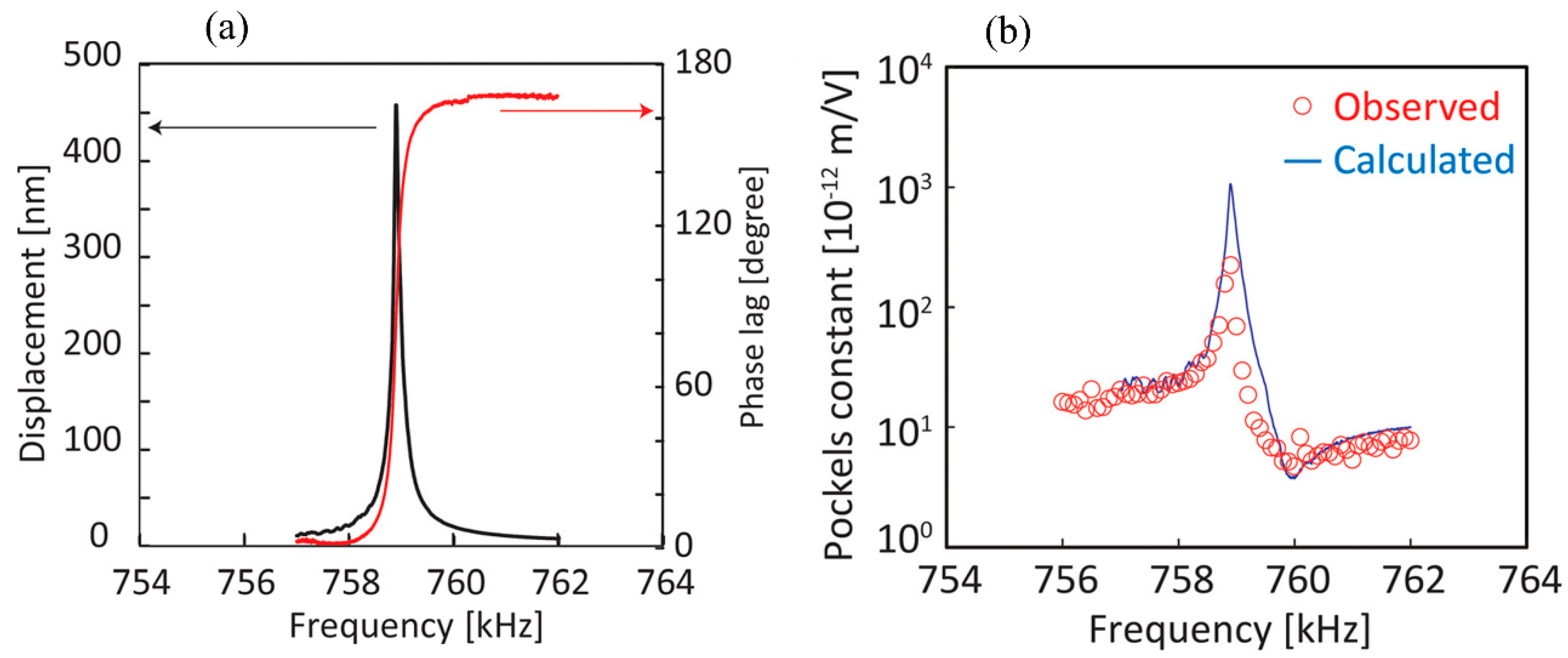
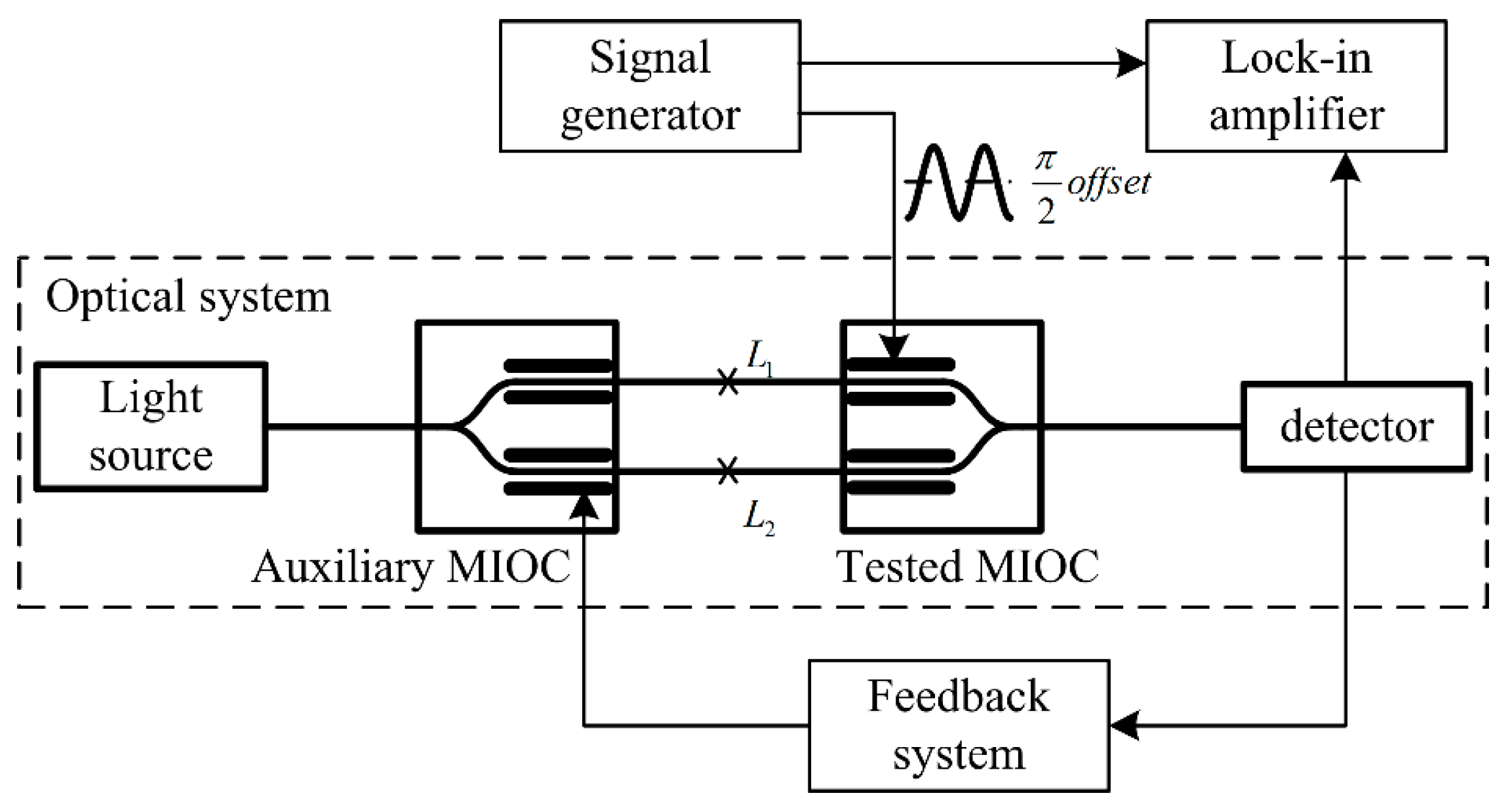
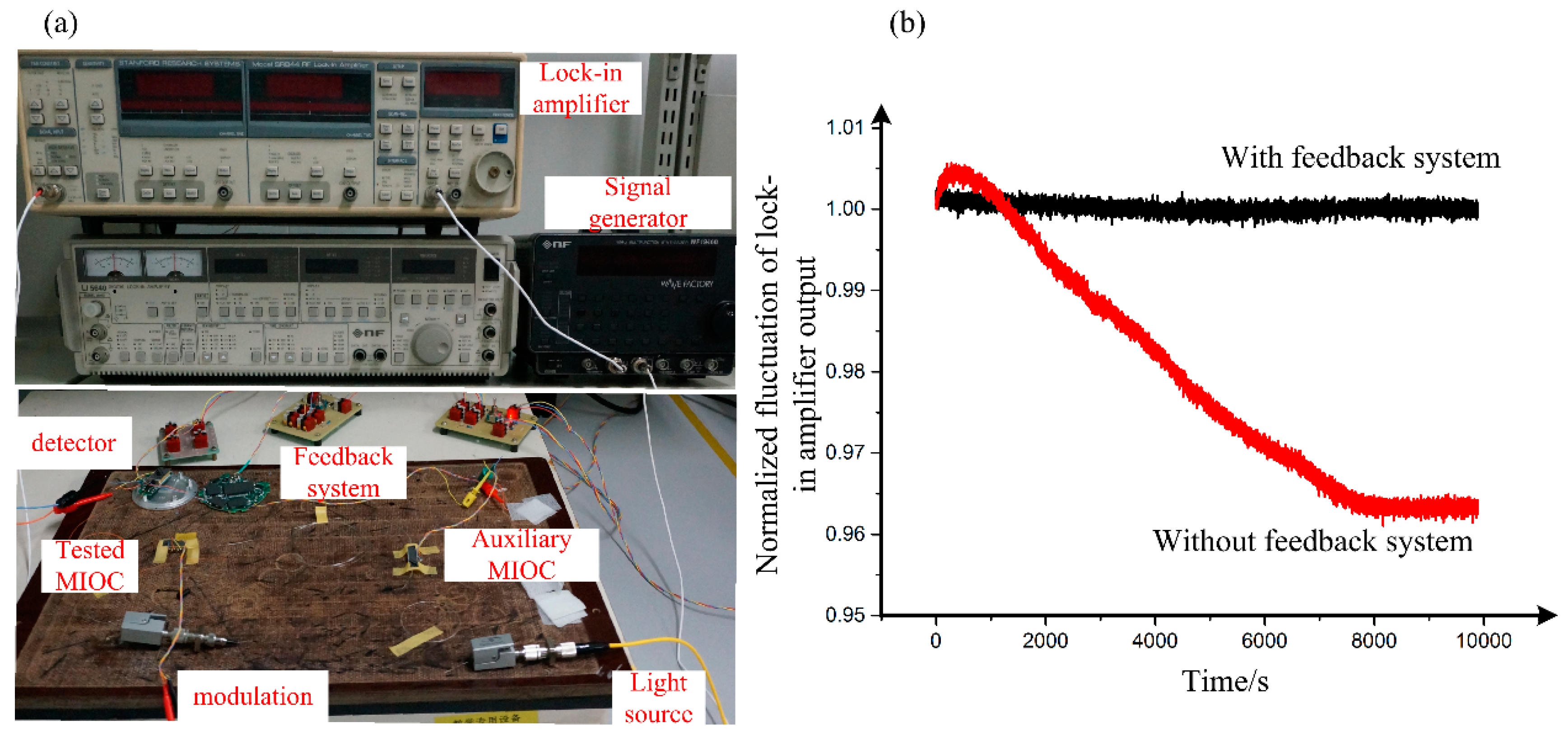



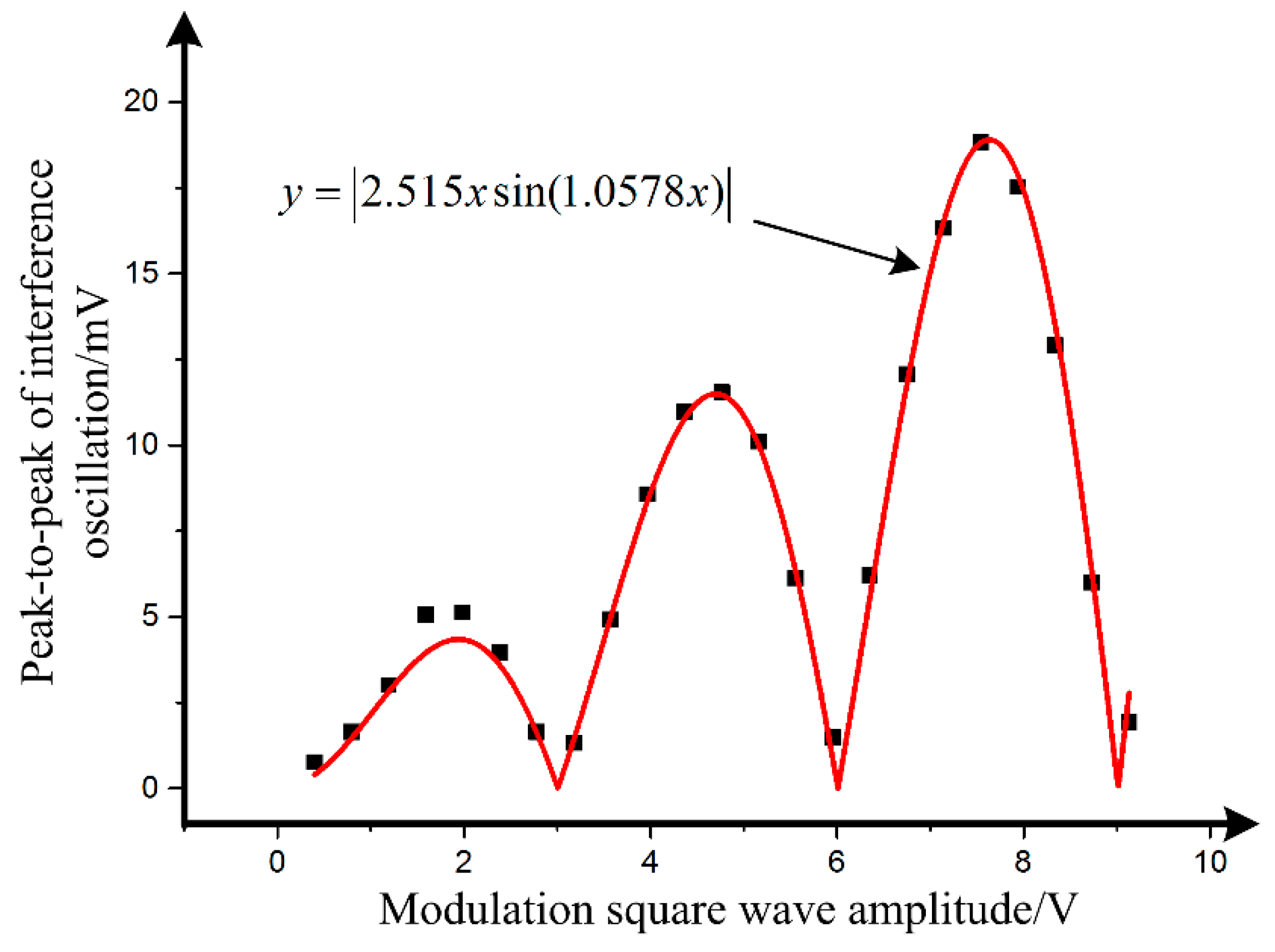
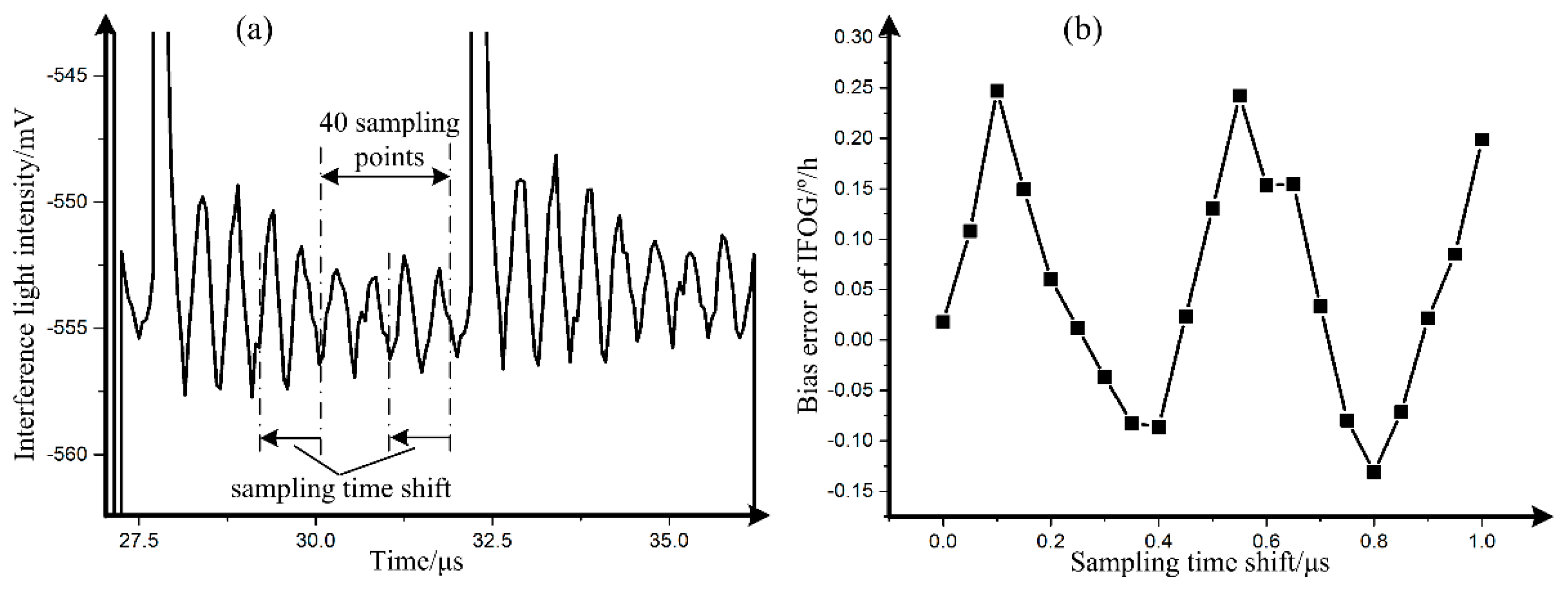
| Parameter | Value |
|---|---|
| Source optical power | 470 μW |
| Total optical losses | 18 dB |
| Detector responsivity | 270 V/mW |
| Radius of fiber coil | 0.1 m |
| Transit time | 4.8 μs |
| Eigen frequency | 104.1 kHz |
| Detector output when no light input | −2.533 V |
© 2019 by the authors. Licensee MDPI, Basel, Switzerland. This article is an open access article distributed under the terms and conditions of the Creative Commons Attribution (CC BY) license (http://creativecommons.org/licenses/by/4.0/).
Share and Cite
Bi, R.; Miao, L.; Huang, T.; Ying, G.; Che, S.; Shu, X. Research on the Frequency-Dependent Halfwave Voltage of a Multifunction Integrated Optical Chip in an Interferometric Fiber Optic Gyroscope. Sensors 2019, 19, 2851. https://doi.org/10.3390/s19132851
Bi R, Miao L, Huang T, Ying G, Che S, Shu X. Research on the Frequency-Dependent Halfwave Voltage of a Multifunction Integrated Optical Chip in an Interferometric Fiber Optic Gyroscope. Sensors. 2019; 19(13):2851. https://doi.org/10.3390/s19132851
Chicago/Turabian StyleBi, Ran, Lijun Miao, Tengchao Huang, Guangyao Ying, Shuangliang Che, and Xiaowu Shu. 2019. "Research on the Frequency-Dependent Halfwave Voltage of a Multifunction Integrated Optical Chip in an Interferometric Fiber Optic Gyroscope" Sensors 19, no. 13: 2851. https://doi.org/10.3390/s19132851




